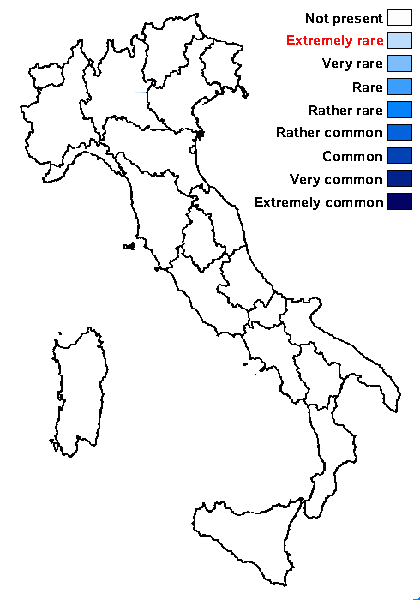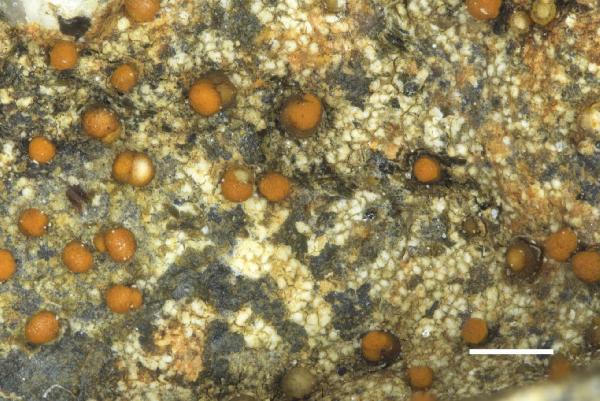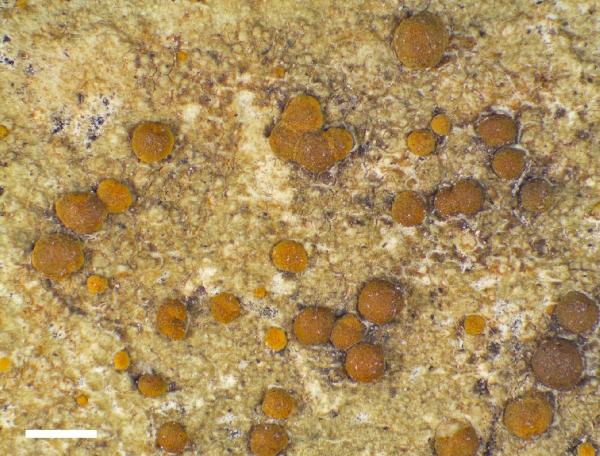Protoblastenia calvella Kainz & Rambold
Bibl. Lichenol., 88: 290, 2004.
Synonyms:
Distribution:
Description: Thallus crustose, usually episubstratic, starting as a thin continuous film, but becoming cracked or even areolate with age, grey to dark brown, sometimes with a greenish hue. Apothecia biatorine, 0.45-0.85 mm across, scattered or in loose groups, sessile and not constricted at base, initially flat to moderately convex and orange to orange-brown, but soon more or less strongly convex and brown-orange to dark red-brown, with a soon excluded proper margin. Proper exciple of parallel-radiating hyphae, colourless to yellowish, patchily pigmented; epithecium c. 15 µm high, orange-brown, with granular crystals reacting K+ purple-red, N-; hymenium colourless 75-115 high; paraphyses branched and anastomosing, 2.5-4 µm thick, the apical cells slightly swollen, 4-5.5 µm wide; hypothecium colourless, occasionally with small amounts of a pink or brownish pigment. Asci 8-spored, clavate, with a well-developed, amyloid tholus containing a more intensely amyloid, indistinct tube structure, without an ocular chamber, approximating the Porpidia- or Psora-types. Ascospores 1-celled, hyaline, broadly ellipsoid to ovoid, 11-14.5 x 6-7 µm, without a distinct perispore. Photobiont chlorococcoid. Spot tests: thallus K-, C-, KC-, P-; apothecia K+ purple-red. Chemistry: apothecia with anthraquinones, mainly parietin. Note: a cryptic species, found on shaded calcareous rocks, so far only known from the Eastern Alps (Austria); to be looked for in the Italian Alps.
Growth form: Crustose
Substrata: rocks
Photobiont: green algae other than Trentepohlia
Reproductive strategy: mainly sexual

Predictive model

Source: Pykälä, J. 2023. Additions to the lichen flora of Finland. X. Graphis Scripta 35 (3): 14–29. Oslo. ISSN 2002- 4495 - CC BY-4.0
Pykälä 44807 (H). Scale bar = 1 mm

Source: Svensson, M., Ekman, S., Arup, U., Eide Ekman, L., Hammarström, O., Isaksson, R., Jonsson, F., Palice, Z., Vicente, R. & Westberg, M. 2024. Further additions to the Swedish flora of lichenised fungi. Graphis Scripta 36 (2): 15–49. Oslo. ISSN 2002-4495. - CC BY-4.0
thin, continuous epilithic thallus and small apothecia (M 0066803).
Bar = 1 mm
Growth form: Crustose
Substrata: rocks
Photobiont: green algae other than Trentepohlia
Reproductive strategy: mainly sexual

Predictive model

Source: Pykälä, J. 2023. Additions to the lichen flora of Finland. X. Graphis Scripta 35 (3): 14–29. Oslo. ISSN 2002- 4495 - CC BY-4.0
Pykälä 44807 (H). Scale bar = 1 mm

 INDEX FUNGORUM
INDEX FUNGORUM
 GBIF
GBIF


